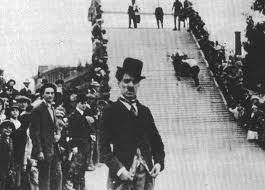Kid Auto Races at Venice

If you’re any sort of Chaplin buff, you probably know that Kid Auto Races at Venice came about because Keystone producer Mack Sennett often had his cameramen and cast go to a live event and film anything funny that might transpire. So it was when Chaplin, the Keystone newcomer, was told to wear a funny costume and attend a kids’ car race in Venice, California.
What you might not know is that this was actually not the first film in which Chaplin wore his now-iconic “Tramp” outfit – just the first such film that was released. Chaplin had actually devised the costume for the short Mabel’s Strange Predicament, which was filmed earlier than Kid Auto Races but was released two days after it. But because this is the Chaplin buff’s version of believing in Santa Claus, we’ll let it slide.
Now, to get down to cases. Chaplin always claimed that he “knew” the Tramp character as soon as he got the costume together and put it on, and according to his My Autobiography, Chaplin instantly regaled Sennett with an on-the-spot character analysis of The Tramp before the camera rolled on the character for the first time.
That’s the stuff that legends are made of, and like most legends, one has to wonder how much of it is true. Nevertheless, even in the muddy-looking copies of Kid Auto that still circulate, there’s something about that crazy little character that makes you bob your head up in delight. In my humble opinion, that “something” is this: He’s in control, right from the start. Look closely at the very first shot of the Tramp. He’s not just trying to get on-camera -- he’s directing. His body language says, “Oh, am I supposed to go off to the right? Very well, then…” – as though he’s actually supposed to be on-camera. And a few dozen head-butts from director Henry Lehrman (the actual and on-screen director of the short) aren’t going to keep the Tramp from his moment of glory.
From then on, the Tramp uses any cheap rationalization at hand to get his face on-screen: Acting as though he’s a car in the race (my favorite moment in the movie), “accidentally” dropping his hat, and admonishing bystanders for offenses not nearly as offensive as his own. And of course, Lehrman wins the battle but loses the war.
The final shot, in which the Tramp sneers and snoots at the camera lens as if to declare victory, is a perfect symbol for the career to come. Not too long after this short was made, most of the world was made to pay attention to this man and realize he wasn’t just another Tramp.
Click here to return to:
HomepageFilmography